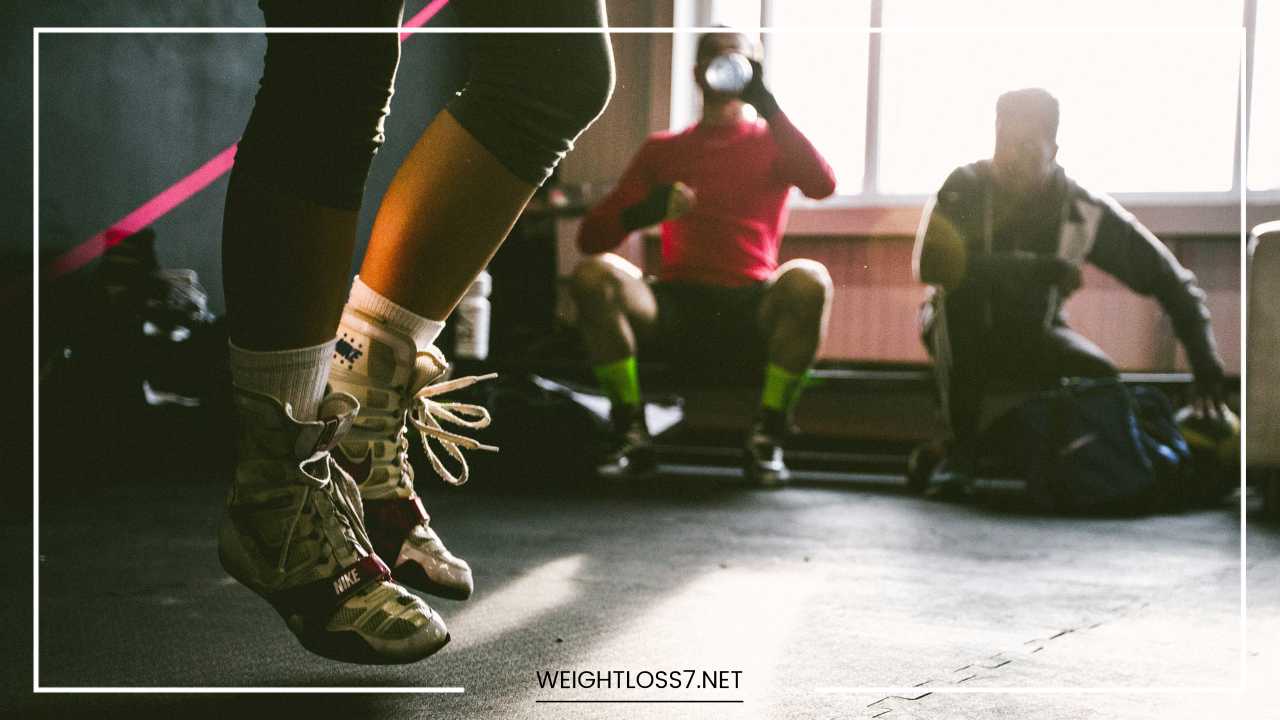Exercise for Weight Loss: Burn Fat & Get Fit

Exercise for Weight Loss
Shedding Pounds and Building Health: The Ultimate Guide to Exercise for Weight Loss
In today’s world, achieving and maintaining a healthy weight is a top priority for many. While diet plays a crucial role in this journey, exercise serves as an equally important pillar for sustainable weight management and overall health improvement.
This comprehensive guide delves into the science behind exercise and weight loss, explores various exercise types in detail, and provides practical tips to craft an effective workout routine tailored to your individual needs.
Unveiling the Weight Loss Equation: Calories In vs. Calories Out
Our bodies maintain weight through a delicate balance between calories consumed (energy intake) and calories burned (energy expenditure).
Weight loss occurs when you create a calorie deficit, meaning you burn more calories than you consume. Exercise plays a vital role in this equation by increasing your calorie expenditure in two primary ways:
- Direct calorie burning: During physical activity, your body utilizes calories for energy. The intensity, duration, and type of exercise directly influence how many calories you burn. High-intensity workouts like sprinting naturally burn more calories per minute compared to walking.
- Indirect calorie burning: Strength training builds and strengthens muscle mass. Muscle tissue, unlike fat, has a higher metabolic rate, meaning it burns more calories even at rest. This translates to an increased calorie expenditure throughout the day, even when you’re not actively exercising.
Demystifying Different Exercise Types for Effective Weight Loss
A well-rounded exercise program for weight loss incorporates a variety of exercise types to maximize benefits, target different muscle groups, and prevent workout plateaus. Here’s a detailed breakdown of some popular options:
1. Cardio (Aerobic Exercise):
- Function: Cardio exercises elevate your heart rate and breathing, promoting efficient oxygen use. This sustained increase in cardiovascular activity strengthens your heart and lungs, leading to improved endurance and overall fitness.
- Benefits for weight loss: Cardio burns a significant amount of calories during the activity, depending on the intensity and duration. Additionally, moderate-intensity cardio can elevate your metabolism for a short period afterward, further increasing calorie expenditure.
- Examples: Brisk walking, running, swimming, cycling, dancing, jumping rope, elliptical training, stair climbing.
- Recommendation: Aim for at least 150 minutes of moderate-intensity cardio or 75 minutes of vigorous-intensity cardio per week, as recommended by the Centers for Disease Control and Prevention (CDC) [1]. You can break this down into smaller, more manageable sessions throughout the week.
2. Strength Training:
- Function: Strength training builds and strengthens muscles through resistance exercises. This can involve bodyweight exercises, free weights, weight machines, or resistance bands.
- Benefits for weight loss: While strength training itself may not burn as many calories per minute compared to cardio, the increased muscle mass it promotes leads to a higher resting metabolic rate (RMR). This means your body burns more calories throughout the day, even at rest, contributing significantly to weight loss efforts. Strength training also improves bone health and posture.
- Examples: Bodyweight exercises (push-ups, squats, lunges, planks), weight lifting (bench press, bicep curls, deadlifts), resistance band exercises.
- Recommendation: Aim for strength training exercises that target all major muscle groups at least twice a week. You can start with lighter weights and gradually increase the weight or difficulty as you get stronger.
3. High-Intensity Interval Training (HIIT):
- Function: HIIT is a training method that alternates between short bursts of high-intensity exercise and periods of rest or low-intensity activity. This creates a demanding yet time-efficient workout.
- Benefits for weight loss: HIIT workouts burn a high number of calories in a shorter amount of time compared to traditional cardio. Additionally, HIIT can elevate your metabolism for an extended period after the workout (EPOC effect), leading to increased calorie burning even at rest. HIIT also improves cardiovascular health and anaerobic capacity (the ability to exercise intensely without oxygen).
- Examples: Sprinting intervals with walking rest periods, jumping jacks with rest, burpees with rest.
- Recommendation: Start slow with HIIT, especially if you’re new to exercise, and gradually increase intensity and duration as your fitness level improves. HIIT workouts can be very demanding, so ensure you listen to your body and take rest days when needed.
4. Other Activities for Weight Loss:
- Non-exercise activity thermogenesis (NEAT): These are everyday activities that increase calorie expenditure, such as taking the stairs instead of the elevator, fidgeting, pacing while talking on the phone, gardening, or doing housework. While NEAT may not burn a significant amount of calories individually, these activities collectively contribute to your daily calorie expenditure.
- Sports and active hobbies: Playing basketball, tennis, badminton, participating in group fitness classes like Zumba or aerobics, hiking, biking, dancing – all these activities can contribute to weight loss goals. They often provide a fun and social way to integrate exercise into your routine.
Choosing the Right Fit: Exercises You Enjoy
Consistency is the key to success in any exercise program. Finding activities you genuinely enjoy is crucial for sticking with your routine in the long run. Here are some tips:
- Explore different types of exercise: Try out various cardio options, strength training routines, HIIT workouts, or even group fitness classes. Discover what sparks joy and keeps you motivated.
- Find your exercise personality: Do you prefer solo workouts or exercising with a buddy? Do you enjoy high-intensity workouts or something more low-impact? Understanding your preferences will help you choose activities you can realistically maintain.
- Make it convenient: Schedule your workouts at a time that works best for your schedule. Consider exercising outdoors, at home, or joining a gym – choose an option that fits your lifestyle.
Crafting Your Personalized Exercise Program:
Here are some steps to design a weight-loss exercise program that works for you:
-
Set SMART Goals:
Specific, Measurable, Achievable, Relevant, and Time-bound goals will help you stay on track. For example, instead of a vague goal of “exercising more,” aim for “30 minutes of moderate-intensity cardio 3 times a week for the next month.” -
Start Gradually:
Begin with a manageable exercise routine, especially if you’re new to exercise. It’s better to start slow and gradually increase intensity and duration as your fitness level improves. This will help prevent injuries and burnout. -
Incorporate Variety:
Include different types of exercise in your program to target different muscle groups, prevent plateaus, and keep your workouts interesting. You can alternate between cardio, strength training, HIIT, and other activities. -
Listen to Your Body:
Rest and recovery are essential for muscle growth and preventing injuries. Don’t push yourself too hard, take rest days when needed, and pay attention to any pain signals. If you experience pain, stop the activity and consult a healthcare professional. -
Warm-up and Cool-down:
Always warm up before your workout to prepare your muscles for exercise and prevent injuries. A warm-up can include light cardio and dynamic stretches. Similarly, cool down after your workout with static stretches to improve flexibility and promote recovery.
Enhancing Your Weight Loss Journey with Exercise:
While exercise is a powerful tool for weight loss, it’s important to remember it works best when combined with a healthy diet:
-
Combine exercise with a calorie-controlled diet:
A balanced, calorie-controlled diet is crucial for weight loss. Focus on whole foods, fruits, vegetables, and lean protein sources. Consult a registered dietitian or nutritionist for personalized dietary guidance. -
Stay hydrated:
Drinking plenty of water helps with overall health, regulates body temperature, and can improve exercise performance. Aim to drink water throughout the day, especially before, during, and after your workouts. -
Track your progress:
Monitor your weight, measurements (waist circumference, hips, etc.), and how you feel. Seeing progress, both physical and in terms of increased energy levels, can be a great motivator to stay on track. Take progress photos if that helps you stay motivated. -
Celebrate your achievements:
Acknowledge your milestones, big or small. Completing a challenging workout, reaching a fitness goal, or simply feeling stronger are all achievements worth celebrating. -
Find a support system:
Tell your friends and family about your weight loss goals and enlist their support. Consider joining a weight loss support group or finding an exercise buddy. Having a support system can make a big difference in your success. -
Consult a healthcare professional:
If you have any underlying health conditions, consult with your doctor before starting a new exercise program. They can help you create a safe and effective workout plan based on your individual needs.
Remember: Weight loss is a journey, not a destination. There will be setbacks and challenges along the way. Focus on making sustainable lifestyle changes, prioritize your health and well-being, and enjoy the process of becoming a healthier, fitter you.

















